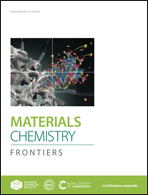Optimizing supramolecular fluorescent materials with responsive multi-color tunability toward soft biomimetic skins†
Abstract
Many natural organisms have evolved to display responsive biofluorescence color changes that facilitate excellent environmental adaptability for camouflage, concealment, protection or signaling. Such interesting phenomena have inspired the development of various artificial fluorescence-color changeable materials with versatile uses, such as responsive displays, encryption, and sensing. However, it is challenging to replicate the dynamic fluorescence color camouflage capacities of living organisms by using soft synthetic materials, but such systems can work as soft biomimetic skins to enhance the function of certain machines (such as robots or prosthetics). Herein, we report a kind of robust supramolecular fluorescent soft material with both multi-color tunability and room-temperature self-healing features on the basis of synergistic multiple hydrogen bonding and dynamic lanthanide coordination interactions. Soft biomimetic camouflage and display skins were further demonstrated, which can be conformally worn on commercial robots to help them merge into different-colored environments or enable on-demand information display in response to a subtle interplay between several environmental stimuli (e.g., humidity, metal ions). This work has made fluorescence color changeable biomimetic skins accessible and is expected to inspire the development of powerful fluorescent materials with as-not-yet-imaginable performance.



 Please wait while we load your content...
Please wait while we load your content...